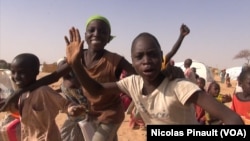Hundreds of thousands of people forced from their homes are now living in the Diffa region of eastern Niger. Makeshift camps are everywhere on each side of the RN1, the country's main highway. The asphalt is boiling hot.
Here, refugees from Nigeria live next to displaced people from Niger. They are two nationalities but have one common fear: Boko Haram.
Mataram Kodogo, a Nigerian, fled her village with her eight children for the relative safety of the Ngourtoua camp.
“It was 2:30 a.m.; it was a Thursday. Boko Haram arrived in our village, shooting, killing people," she said. "It was every man for himself. People were fleeing undressed, without shoes. I put my baby on my back, took another child under my arm, and I dragged another.”
Others in the camps tell similarly horrible stories. Even with the Niger army on patrol, displaced people and refugees are scared. Daily life is not easy.
Hunger problem
The food situation is at best precarious. Last year, the United Nations estimated that the region's harvest would not meet local needs, falling short by 100,000 tons of cereals.
The U.N. refugee agency has said efforts to help the displaced are complicated because they are spread out for 30 kilometers along RN1 instead of being in a proper camp. Aid officials aren't even sure how many people they are dealing with.
"We know that many people have no IDs," said Karl Steinacker, the U.N. agency's representative in Niger. "It is extremely difficult to say where they are from. But, as of right now, we have more displaced people than Nigerian refugees."
He estimated the Diffa region's total population at 700,000, including 100,000 Nigerian refugees. "And at least half of them are displaced or in need,” he told VOA.
Many refugees or displaced people say they would return to their homes if security improved, but the chances of this seem remote. Boko Haram is still active along the Komadugu Yobe River, the natural border between Niger and Nigeria.












